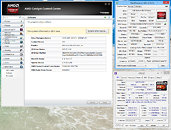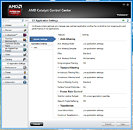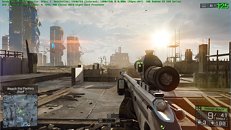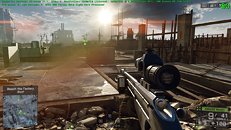Saturday, February 1st 2014

AMD Passes On Catalyst 14.1 beta to the Press, Public Release Shortly
After last minute hiccups, AMD managed to release Catalyst 14.1 beta to the press. The driver brings along the first release of Mantle, AMD's ambitious 3D graphics API to rival Direct3D and OpenGL. Installing the driver was less than straightforward. We couldn't just install the driver over our Catalyst 13.12 WHQL installation like we normally do. A driver cleanup and reinstalling did the trick. Catalyst 14.1 beta enables the 3D renderer option in Battlefield 4, which lets you choose between DirectX 11.1 and Mantle.
Our first (subjective) impression, is that we couldn't tell the difference. Our Radeon R9 290 already offered frame-rates well above 60 FPS (1920 x 1080, Ultra, 4x MSAA), on Direct3D, and so we never really stood to gain anything that makes the game more playable than it already was. What could have been interesting, was to see how Mantle makes the lives of R9 270X owners better, who could see frame-rates drop below 60 FPS at our settings. According to a change-log of the driver posted by Guru3D, AMD hasn't optimized Mantle for any of the Graphics CoreNext (GCN) based GPUs other than Radeon R9 290 series, R9 260X, and A-Series "Kaveri" APUs.We gave Battlefield 4 and the Catalyst 14.1 a quick spin. Our test bed included an AMD FX-8350 chip at stock frequencies, 8 GB of DCh DDR3-1333 memory, an AMD 990FX motherboard (ASUS M5A99FX-PRO R2.0, 2201 BIOS, UEFI mode); Windows 8.1 64-bit, and of course, a Radeon R9 290 (BIOS: 015.042.000.000.003747). The GPU is into high-end territory, but the rest of the bed is still what we'd like to call an "aspirational mainstream" build (one that's penny-pinching but shouldn't bottleneck high-end GPUs). Game settings included 1920 x 1080 pixels resolution, disabled V-Sync, "Ultra" preset, HBAO, and 4x MSAA. We used the "PerfOverlay.FrameFileLogEnable 1" console command to spit out CSV files with frame-times in ms, from which we drew average frame-times (time in ms taken to draw a frame), and derived frames per second. Switching between renderers requires game restarts.
The screenshots above are not from the testing session. In the first run, we chose the Direct3D renderer. Battlefield 4 takes advantage of DirectX 11.1 (feature-level 11.1) on the R9 290. We employed a 167-second play through the single-player campaign chapter "Fishing in Baku," with a constant save-point, where our heroes are fighting their way through hordes of enemies to reach their extraction point. We obtained an average frame-time of 16.26 ms, which works out to 61.5 fps. For Mantle, we overshot the 167-second mark, and played on for 184 seconds (we quit at the same point in in the game as our Direct3D run). The average frame-time was 14.45 ms, which works out to 69.2 fps. Overall, a 12.5 percent performance uplift. On a side-note, in the screenshots above, which we took merely to show you that the Mantle renderer is active, the game is doing 1280 x 720 pixels, and windowed. This is a CPU-limited scenario. The performance uplift is higher.
Overall, Mantle is far from being termed vaporware. It works like gangbusters, and we couldn't visually tell the difference in game effects between it and Direct3D. Performance gains are tangible, and if AMD gets it to work like it should on mid-thru-performance segment GPUs such as the R9 270 series and R9 280 series; not to mention HD 7800 series and HD 7900 series, AMD owners could be in for a neat free performance upgrade, heck even lower-mainstream chips like the R7 260X and HD 7790 should turn from being 1080p-capable to 1080p-worthy. Mantle works to reduce the API-level overheads imposed on the rest of the system (the CPU, main memory, etc.), in processing graphics. The more CPU-limited the scenario, the better the performance uplift. AMD tells us that public release of Catalyst 14.1 beta should be posted on the company website shortly.
Our first (subjective) impression, is that we couldn't tell the difference. Our Radeon R9 290 already offered frame-rates well above 60 FPS (1920 x 1080, Ultra, 4x MSAA), on Direct3D, and so we never really stood to gain anything that makes the game more playable than it already was. What could have been interesting, was to see how Mantle makes the lives of R9 270X owners better, who could see frame-rates drop below 60 FPS at our settings. According to a change-log of the driver posted by Guru3D, AMD hasn't optimized Mantle for any of the Graphics CoreNext (GCN) based GPUs other than Radeon R9 290 series, R9 260X, and A-Series "Kaveri" APUs.We gave Battlefield 4 and the Catalyst 14.1 a quick spin. Our test bed included an AMD FX-8350 chip at stock frequencies, 8 GB of DCh DDR3-1333 memory, an AMD 990FX motherboard (ASUS M5A99FX-PRO R2.0, 2201 BIOS, UEFI mode); Windows 8.1 64-bit, and of course, a Radeon R9 290 (BIOS: 015.042.000.000.003747). The GPU is into high-end territory, but the rest of the bed is still what we'd like to call an "aspirational mainstream" build (one that's penny-pinching but shouldn't bottleneck high-end GPUs). Game settings included 1920 x 1080 pixels resolution, disabled V-Sync, "Ultra" preset, HBAO, and 4x MSAA. We used the "PerfOverlay.FrameFileLogEnable 1" console command to spit out CSV files with frame-times in ms, from which we drew average frame-times (time in ms taken to draw a frame), and derived frames per second. Switching between renderers requires game restarts.
The screenshots above are not from the testing session. In the first run, we chose the Direct3D renderer. Battlefield 4 takes advantage of DirectX 11.1 (feature-level 11.1) on the R9 290. We employed a 167-second play through the single-player campaign chapter "Fishing in Baku," with a constant save-point, where our heroes are fighting their way through hordes of enemies to reach their extraction point. We obtained an average frame-time of 16.26 ms, which works out to 61.5 fps. For Mantle, we overshot the 167-second mark, and played on for 184 seconds (we quit at the same point in in the game as our Direct3D run). The average frame-time was 14.45 ms, which works out to 69.2 fps. Overall, a 12.5 percent performance uplift. On a side-note, in the screenshots above, which we took merely to show you that the Mantle renderer is active, the game is doing 1280 x 720 pixels, and windowed. This is a CPU-limited scenario. The performance uplift is higher.
Overall, Mantle is far from being termed vaporware. It works like gangbusters, and we couldn't visually tell the difference in game effects between it and Direct3D. Performance gains are tangible, and if AMD gets it to work like it should on mid-thru-performance segment GPUs such as the R9 270 series and R9 280 series; not to mention HD 7800 series and HD 7900 series, AMD owners could be in for a neat free performance upgrade, heck even lower-mainstream chips like the R7 260X and HD 7790 should turn from being 1080p-capable to 1080p-worthy. Mantle works to reduce the API-level overheads imposed on the rest of the system (the CPU, main memory, etc.), in processing graphics. The more CPU-limited the scenario, the better the performance uplift. AMD tells us that public release of Catalyst 14.1 beta should be posted on the company website shortly.




64 Comments on AMD Passes On Catalyst 14.1 beta to the Press, Public Release Shortly
@ 1440p, ultra settings:
Mantle 7.3 % faster than DirectX11 on average. Mantle has lower minimum fps due to quite rare random high latency frames.
@ 1440p, low settings
Mantle 16.5 % faster than DirectX11 on average. Mantle has lower minimum fps due to quite rare random high latency frames.
Test setup:
3930K @ 4.2GHz
Asus Rampage IV Formula
32GB 2133MHz CL9 ram
AMD R9 290X @ stock "uber"
Samsung 840 Pro 256GB
1000W PSU
Win 8.1
Cat 14.1 Beta
Some stability problems ? were present. Crashing randomly with Mantle API. But not bad for first try. ;)
:roll:
Besides, Press driver is FAR from standard driver installer. Let the guys at AMD fix it for a bit more.
sssssshhh
Now to count my fat roll of Benjamins.:rolleyes:
Black screen issue is caused by AMD not optimizing the GPU to timings of Elpida-made memory chips. There could be a BIOS update in the works. My 042 BIOS reduced black-screens greatly, but not eliminated the issue. You can find it in our BIOS DB.
forums.guru3d.com/showthread.php?t=386270
No registration req.
Thanks asder00